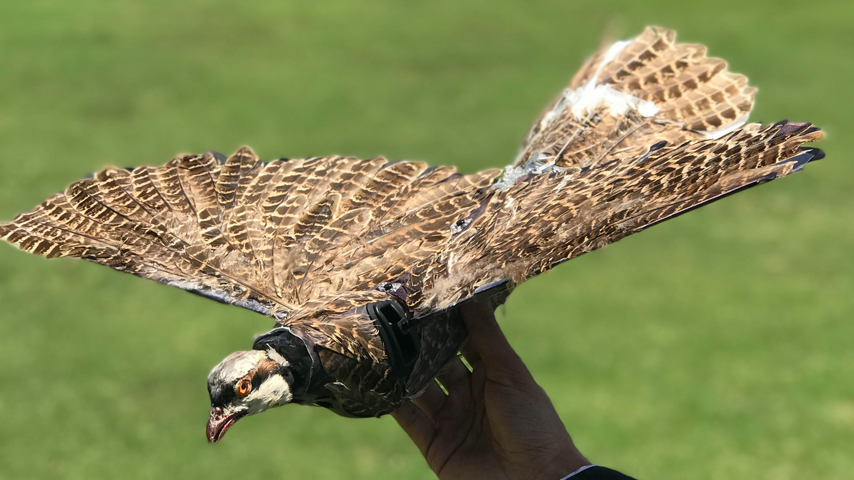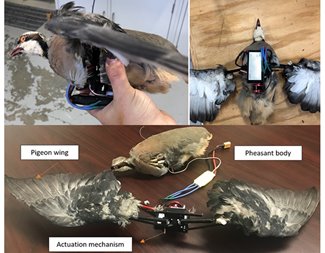An Avian Drone Flaps Its Way into the Sky
An Avian Drone Flaps Its Way into the Sky


A drone platform fitted into the cavity of a taxidermy bird can fly using its wings, and help study wildlife.
Researchers often look to animals and insects for clues in designing robots to perform numerous tasks. Engineers at New Mexico Institute of Mining and Technology are taking that one step further with the design of a drone fitted into the body cavity of a pheasant that flies using its wings.
Mostafa Hassanalian, an associate mechanical engineering professor at New Mexico Tech in Socarro, has been working with drones and robots since 2009, devising robots that mimic the movements of spiders, for instance, and other creatures. He’s been working to develop a drone with flapping wings since his master’s thesis.
“I actually built a couple of them,” he said. “They were small sized, and we used artificial material like mylar or rods for building the structure of a flapping wing. But they did not have enough to generate aerodynamic forces like lift and thrust.”
He then turned to birds themselves, or dead ones that already were preserved through taxidermy. (Hassanalian emphasized that live birds were not killed for the drone project.) The birds, or individual parts such as feathers or wings, were purchased through taxidermy professionals. The objective is to use what appears to be a live bird in studying wildlife migration, behavior, and energy conservation.
“Currently, drones are being used for wildlife monitoring, mainly quad copters, and there are many challenges,” he said. “Drones can expose an animal to danger. They may be seen as a predator and suffer pretty good damage to the propellers. And drones create a lot of noise. This led us to find a nature-friendly drone for wildlife monitoring.
Hassanalian built multiple prototypes in developing an actuation mechanism that would work, including hummingbird wings attached to a flapping mechanism. Using a pigeon attached to mechanical body proved the stroke and downstroke flapping motion.
Become a Member: How to Join ASME
The biggest advantage is not having to design and build a wing, a task that is difficult to model and size, he said.
“We cannot get the same efficiency as the actual wing or tail,’” Hassanalian said. “With the bird, the bone is already there and we get the flexibility that is already there. We are doing reverse engineering.”
All electronics are fitted inside the body cavity, including the battery. The motor is attached to the wings, which flap with enough power to lift off and fly for a maximum of about 20 minutes. The drone is not as agile as a real bird, but it can hover and glide on air currents. He and a team of graduate students and researchers are working to extend the flight time and range.
Hassanalian also is studying the dynamics of migratory flight, taking advantage of the school’s location to the Bosque del Apache National Wildlife Refuge, a major wintering ground for cranes, geese, and other birds that fly thousands of miles from nesting grounds in the arctic.
More for You: 5 Ways Drone Technology is Improving
“If you look at Canada geese, they fly 2,400 kilometers in a day and a half, so we tried to explore this,” he said. “What we observe is that the birds in the lead position consume more energy and the others conserve more energy. Then they start to change position. We developed analytical modeling to explore this and understand birds have different ages, different levels of experience.”
Hassanalian said geese can cover 44 percent more distance when they start to switch positions in their formation. To better understand those dynamics, researchers are using gliders or single-seat airplanes to fly with the flocks. But that can lead to distractions.
“The technology we are developing actually would allow us to fly with the flock of birds and understand how they decide to switch, and when they decide to switch,” he said.
Other research focuses on feather coloration and how it affects flight efficiency. Hassanalian and his team observed that oceanic birds like the albatross have dark feathers on their upper body and white feathers on their lower body. Traditional biological research generally ties coloration to mating or camouflage.
The New Mexico researchers have a different theory, tied to flight efficiency. “If you look at oceanic birds, they all have black color at the top and they have white at the bottom and sides,” Hassanalian noted. “But we’ve shown that black color absorbs more heat than white, so it changes the flow pattern around the wing and helps them fly easier, reducing drag and increasing lift.”
The work has applications in aviation where Hassanalian believes simply painting airplane wings can change airflow and save energy.
John Kosowatz is senior editor.
Mostafa Hassanalian, an associate mechanical engineering professor at New Mexico Tech in Socarro, has been working with drones and robots since 2009, devising robots that mimic the movements of spiders, for instance, and other creatures. He’s been working to develop a drone with flapping wings since his master’s thesis.
“I actually built a couple of them,” he said. “They were small sized, and we used artificial material like mylar or rods for building the structure of a flapping wing. But they did not have enough to generate aerodynamic forces like lift and thrust.”
He then turned to birds themselves, or dead ones that already were preserved through taxidermy. (Hassanalian emphasized that live birds were not killed for the drone project.) The birds, or individual parts such as feathers or wings, were purchased through taxidermy professionals. The objective is to use what appears to be a live bird in studying wildlife migration, behavior, and energy conservation.
“Currently, drones are being used for wildlife monitoring, mainly quad copters, and there are many challenges,” he said. “Drones can expose an animal to danger. They may be seen as a predator and suffer pretty good damage to the propellers. And drones create a lot of noise. This led us to find a nature-friendly drone for wildlife monitoring.
Hassanalian built multiple prototypes in developing an actuation mechanism that would work, including hummingbird wings attached to a flapping mechanism. Using a pigeon attached to mechanical body proved the stroke and downstroke flapping motion.
Become a Member: How to Join ASME
The biggest advantage is not having to design and build a wing, a task that is difficult to model and size, he said.
“We cannot get the same efficiency as the actual wing or tail,’” Hassanalian said. “With the bird, the bone is already there and we get the flexibility that is already there. We are doing reverse engineering.”
All electronics are fitted inside the body cavity, including the battery. The motor is attached to the wings, which flap with enough power to lift off and fly for a maximum of about 20 minutes. The drone is not as agile as a real bird, but it can hover and glide on air currents. He and a team of graduate students and researchers are working to extend the flight time and range.
Hassanalian also is studying the dynamics of migratory flight, taking advantage of the school’s location to the Bosque del Apache National Wildlife Refuge, a major wintering ground for cranes, geese, and other birds that fly thousands of miles from nesting grounds in the arctic.
More for You: 5 Ways Drone Technology is Improving
“If you look at Canada geese, they fly 2,400 kilometers in a day and a half, so we tried to explore this,” he said. “What we observe is that the birds in the lead position consume more energy and the others conserve more energy. Then they start to change position. We developed analytical modeling to explore this and understand birds have different ages, different levels of experience.”
Hassanalian said geese can cover 44 percent more distance when they start to switch positions in their formation. To better understand those dynamics, researchers are using gliders or single-seat airplanes to fly with the flocks. But that can lead to distractions.
“The technology we are developing actually would allow us to fly with the flock of birds and understand how they decide to switch, and when they decide to switch,” he said.
Other research focuses on feather coloration and how it affects flight efficiency. Hassanalian and his team observed that oceanic birds like the albatross have dark feathers on their upper body and white feathers on their lower body. Traditional biological research generally ties coloration to mating or camouflage.
The New Mexico researchers have a different theory, tied to flight efficiency. “If you look at oceanic birds, they all have black color at the top and they have white at the bottom and sides,” Hassanalian noted. “But we’ve shown that black color absorbs more heat than white, so it changes the flow pattern around the wing and helps them fly easier, reducing drag and increasing lift.”
The work has applications in aviation where Hassanalian believes simply painting airplane wings can change airflow and save energy.
John Kosowatz is senior editor.




